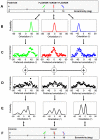A neurophysiologically plausible population code model for feature integration explains visual crowding
- PMID: 20098499
- PMCID: PMC2799670
- DOI: 10.1371/journal.pcbi.1000646
A neurophysiologically plausible population code model for feature integration explains visual crowding
Abstract
An object in the peripheral visual field is more difficult to recognize when surrounded by other objects. This phenomenon is called "crowding". Crowding places a fundamental constraint on human vision that limits performance on numerous tasks. It has been suggested that crowding results from spatial feature integration necessary for object recognition. However, in the absence of convincing models, this theory has remained controversial. Here, we present a quantitative and physiologically plausible model for spatial integration of orientation signals, based on the principles of population coding. Using simulations, we demonstrate that this model coherently accounts for fundamental properties of crowding, including critical spacing, "compulsory averaging", and a foveal-peripheral anisotropy. Moreover, we show that the model predicts increased responses to correlated visual stimuli. Altogether, these results suggest that crowding has little immediate bearing on object recognition but is a by-product of a general, elementary integration mechanism in early vision aimed at improving signal quality.
Conflict of interest statement
The authors have declared that no competing interests exist.
Figures







Similar articles
-
Efficient integration across spatial frequencies for letter identification in foveal and peripheral vision.J Vis. 2008 Oct 17;8(13):3.1-20. doi: 10.1167/8.13.3. J Vis. 2008. PMID: 19146333 Free PMC article.
-
Ladder contours are undetectable in the periphery: a crowding effect?J Vis. 2007 Oct 29;7(13):9.1-15. doi: 10.1167/7.13.9. J Vis. 2007. PMID: 17997637
-
The nature of letter crowding as revealed by first- and second-order classification images.J Vis. 2007 Feb 7;7(2):5.1-26. doi: 10.1167/7.2.5. J Vis. 2007. PMID: 18217820 Free PMC article.
-
A review of interactions between peripheral and foveal vision.J Vis. 2020 Nov 2;20(12):2. doi: 10.1167/jov.20.12.2. J Vis. 2020. PMID: 33141171 Free PMC article. Review.
-
Visual crowding: a fundamental limit on conscious perception and object recognition.Trends Cogn Sci. 2011 Apr;15(4):160-8. doi: 10.1016/j.tics.2011.02.005. Epub 2011 Mar 21. Trends Cogn Sci. 2011. PMID: 21420894 Free PMC article. Review.
Cited by
-
Visual crowding in V1.Cereb Cortex. 2014 Dec;24(12):3107-15. doi: 10.1093/cercor/bht159. Epub 2013 Jul 5. Cereb Cortex. 2014. PMID: 23833128 Free PMC article.
-
Crowding and Binding: Not All Feature Dimensions Behave in the Same Way.Psychol Sci. 2019 Oct;30(10):1533-1546. doi: 10.1177/0956797619870779. Epub 2019 Sep 18. Psychol Sci. 2019. PMID: 31532700 Free PMC article.
-
Electrophysiological evidence for failures of item individuation in crowded visual displays.J Cogn Neurosci. 2014 Oct;26(10):2298-309. doi: 10.1162/jocn_a_00649. Epub 2014 Apr 16. J Cogn Neurosci. 2014. Retraction in: J Cogn Neurosci. 2014 Oct;26(10):2298-2309. PMID: 24738774 Free PMC article. Retracted.
-
Studying Cortical Plasticity in Ophthalmic and Neurological Disorders: From Stimulus-Driven to Cortical Circuitry Modeling Approaches.Neural Plast. 2019 Nov 3;2019:2724101. doi: 10.1155/2019/2724101. eCollection 2019. Neural Plast. 2019. PMID: 31814821 Free PMC article. Review.
-
Peripheral vision and pattern recognition: a review.J Vis. 2011 Dec 1;11(5):13. doi: 10.1167/11.5.13. J Vis. 2011. PMID: 22207654 Free PMC article. Review.
References
-
- Korte W. Über die Gestaltauffassung im indirekten Sehen. Zeitschrift für Psychologie. 1923;93:17–82.
-
- Stuart JA, Burian HM. A study of separation difficulty. Its relationship to visual acuity in normal and amblyopic eyes. Am J Ophthalmol. 1962;53:471–477. - PubMed
-
- Bouma H. Interaction effects in parafoveal letter recognition. Nature. 1970;226:177–178. - PubMed
Publication types
MeSH terms
LinkOut - more resources
Full Text Sources

